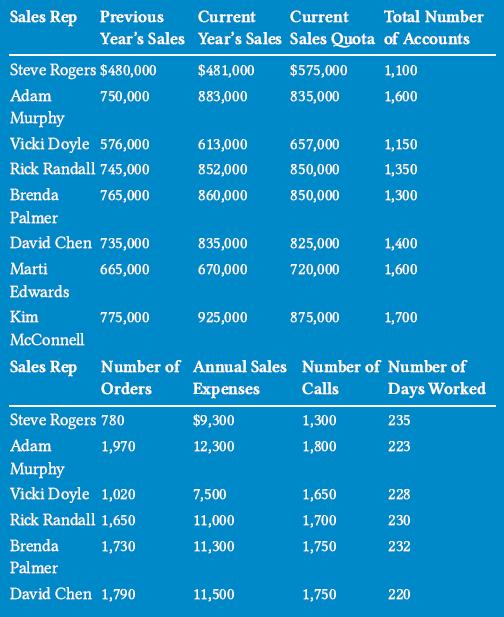Jamie Walker, regional vice president of sales for American Food Processors (AFP), is looking at the performance
Question:
Jamie Walker, regional vice president of sales for American Food Processors (AFP), is looking at the performance numbers of his sales force for the past year. He is starting to get that sinking feeling he gets every year at this time. Once again he has to evaluate the performance of his sales force, and he is not looking forward to the exercise. The problem is that Jamie really likes all of his sales reps as people. Because of that, he would like to use more subjective criteria in evaluating them. He thinks they all do a good job, and many of them have extenuating circumstances that just don’t show up in the objective performance data the company requires him to use. Jamie knows from having been a sales rep himself for eight years before getting into sales management that various things come up each year that can drastically affect a salesperson’s territory. A large customer may go out of business, a competitor may place renewed emphasis on gaining accounts in a certain territory, or the economy may simply be poor for some customers. Any one of these events or many others can significantly impair a salesperson’s performance, and the rep has little to no influence on these events. Nonetheless, AFP’s evaluation process for the time being is numbers-driven. Jamie will have to get to work calculating the required ratios and rank-ordering his sales reps before holding his annual performance review meetings with each rep next week. In looking at the performance data, Jamie immediately sees an example of why objective performance information by itself is not the best way to evaluate a sales force. The standard number of days any representative could work in his or her territory for the year was 240 (52 weeks/year 5 days/week – 10 holidays – 10 travel and meeting days). Since Steve Rogers has been with the company for just over a year, he gets only one week of vacation. However, Marti Edwards combined her two weeks of vacation with six weeks of maternity leave when her baby was born. Such discrepancies in the number of days worked affect the evaluation process, but going strictly by the numbers doesn’t allow for any consideration of those extenuating circumstances. Jamie also notices that Rick Randall, who was originally on his way to having a breakout year, barely exceeded quota. One of Rick’s largest customers went bankrupt nine months into the year, and he had a hard time recovering from that setback.
Table 1


As Jamie continues to ponder the task before him, he knows that the other three regional sales VPs are working on the same assignment. He also begins to realize (as he does every year) that there are as many extenuating circumstances as there are salespeople considering them all when evaluating performance would be an impossible task. Maybe looking at only the numbers and ratios is the fairest method after all.
Questions
1. Using the information provided in Table 1, rank Jamie’s sales representatives from best to worst by calculating and considering the following ratios: sales growth, sales to quota, sales per account, average order size, sales expense, calls per day, and orders per call (hits).
2. Suppose you are Jamie Walker and you’re holding the annual review meeting with each of these sales reps. What recommendations will you give to the four lowest-ranking reps to improve their sales?
3. What are some of the limitations of using only ratios to evaluate members of AFP’s sales force? How could Jamie improve the performance evaluation process so that other information is considered? If Jamie could convince AFP to consider other performance information, what other information do you recommend he use?
Step by Step Answer:

Contemporary Selling Building Relationships Creating Value
ISBN: 102447
5th Edition
Authors: Mark W. Johnston, Greg W. Marshall





